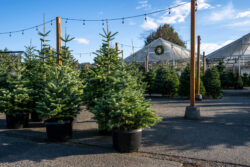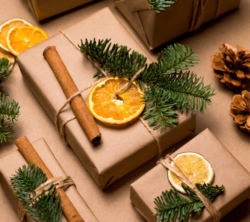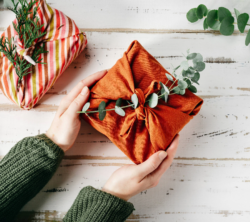How to Have a More Sustainable Christmas

While Christmas can be a time of great joy for many, it can also be one of excessive waste. From wrapping paper to wasted food, you may find yourself dreaming of a green Christmas. As we prepare to head home for the festive break, here are seven top tips on how to have a more sustainable Christmas.
1. The Christmas Tree Dilemma:
Real or fake? A question we often get asked is whether it’s better to fell trees for Christmas each year or choose a fake, but plastic, one. You can skip this problem to some extent if you opt for a potted tree that can be replanted or reused year on year, or if you don't have a lot of space why not choose something else in your house that can be decorated?
If you already have a plastic tree, it’s estimated that you would need to use it for at least ten years for it to have a lower carbon impact than a ‘real’ tree. So don't ditch it just because it’s plastic!
If you do have a felled tree, look for Christmas tree recycling schemes in your area. They can reduce the carbon impact of your Christmas tree significantly by making sure the trees are disposed of responsibly. Many also contribute to local charities. Check out schemes like Sue Ryder Christmas Treecycling in Leeds.

2. Mindful Food Consumption:
Food is a real focus for many at Christmas – but food waste, even if composted, has a huge impact globally. Christmas is the perfect time for reusing leftovers, and if you freeze some you’ll have plenty to enjoy during what sometimes seems like the endless month of January.
Plan out your Christmas meals and keep an eye on what’s in your fridge so you can reduce food waste. A sustainable Christmas is also about making the most of what you have, especially when it’s delicious Christmas fare!
Integrating seasonal plant-based food into your festive meals is also a great way to lower your carbon impact and try something delicious and new. For low-cost plant-based ideas check out Max La Manna’s Christmas menu!
3. Sustainable Gifting:
Thinking about a gift's lasting impact is a great way to have a more sustainable Christmas. Choose items that are durable, meaningful, and will be cherished for a long time. Don’t be afraid to ask someone what they want. You could agree to a ‘secret Santa’ where you each buy one thoughtful gift for a person in the group rather than lots of smaller gifts that they might not need.
Resource-light gifts are great. Think home-made decorations made from dried oranges and cinnamon sticks, a charity donation in the name of the person you’re gifting it to, or a playlist or scrapbook. A repair kit can also be a thoughtful present which is genuinely useful and promotes the longevity of items.
Home-made treats are also lovely gifts that don’t have to contribute towards increased waste. Think nicely wrapped jams, Christmas chutney, festive cookies, rhubarb liqueur or a cordial!

4. Shop Second Hand or Support Local Businesses:
Embrace the thrill of second-hand shopping. Whether it's gifts or decorations, you'll not only find unique items but also contribute to reducing waste.
Alternatively, choose local products and support businesses in your community. Not only does this reduce your carbon impact, but it also helps sustain local economies.
If you do have to shop online, consider purchasing items that have a positive environmental impact if you can afford it. For example, clothing company TenTree plants ten trees on every purchase.

5. Rethinking Wrapping:
Give your presents a stylish eco-twist by wrapping them using recycled newspaper, gift paper, or brown paper from deliveries. Consider using fabric tied with string or ribbon for a reusable and aesthetic alternative. Pillow cases, old scarves and tea towels all make good wrapping ‘paper’. It is also okay to not wrap your gifts at all!

6. Choose Quality Time over Quantity of Gifts:
One of the great things about the Christmas break can be the ability to spend quality time with friends, family or even distant relatives you only see once in a while. Lots of physical gifts can contribute to unnecessary emissions and waste while also making the festive period more stressful and expensive. Talk to those you celebrate with about shifting the focus away from gifts and towards experiences and memories instead.
7. Reuse Decorations:
If your decorations are looking tired, why not get creative with a touch of paint. You can get paint markers that make it easy to give them a fresh look, even if you don’t think you have an artistic flair. Don’t forget natural decorations too! Forage for holly and twigs on your local walks, or dry slices of oranges in a low temperature oven (pop them in when you’ve finished cooking and your oven is cooling).
If you’ve had your Christmas lights for a while then they are one decoration that might be worth updating. Ones with LED bulbs consume a lot less energy and are safer too!
Give a second life to Christmas cards from previous years; cut them in half and use the front as gift tags or upcycle them into new cards. Make your Christmas dinner table more eco-friendly by choosing crackers with useful or edible gifts inside, or opt for fill-your-own crackers.

To Conclude
We hope these tips help you to get curious about your seasonal traditions and to consider making eco-friendly adjustments to have a more sustainable Christmas.
Wishing you a merry Christmas from all of us at the University of Leeds Sustainability Service!
Keep up to date on the latest news
-
- Follow us on Twitter: @UoL_Sus
- Follow us on Instagram: @uol_sus
- Follow us on Facebook: @UoLSustainability
- Sign up to our Sustainability newsletter
United Nations Sustainable Development Goals
We use the United Nations Sustainable Development Goals (SDGs) as a framework to guide our activity. Our work on sustainable consumption is linked to the following SDGs:
-
-
- Goal 12: Responsible Consumption and Production
-
Find out more about our impact on the SDGs.

